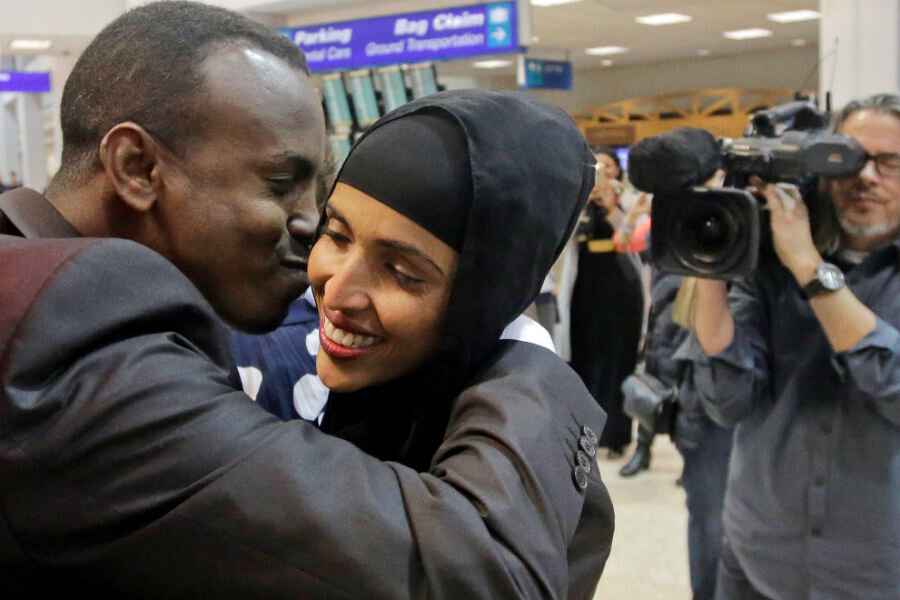Who are the refugees and immigrants entering the US since the travel ban was lifted?
Loading...
In an apparent reference to a Washington Times report published last week, President Trump took to Twitter Saturday to warn Americans of a "dangerous" surge in immigration since his executive order temporarily banning refugees from seven majority-Muslim countries was blocked earlier this month.
"Our legal system is broken!" the president tweeted. "77% of refugees allowed into U.S. since travel reprieve hail from seven suspect countries. (WT) SO DANGEROUS!"
The Washington Times reported on Thursday that since the Feb. 3 suspension of Mr. Trump's order by a federal judge, 77 percent of the 1,100 refugees who had entered the country had been from the seven countries targeted in the order, with nearly a third hailing from Syria alone.
While the numbers are largely accurate, experts warn against jumping to conclusions, as there may be more to those statistics than meets the critic's eye.
According to the US State Department, more than 70 percent of the roughly 1,400 refugees admitted to the US from Feb. 4 to Feb. 10 have indeed come from Iran, Iraq, Syria, Somalia, Sudan, Libya, and Yemen – and those numbers do indeed suggest an effort by the State Department and refugee resettlement agencies to resettle as many people as possible amid a period of uncertainty in the days immediately following the suspension.
That surge, however, reflects not an influx of new refugees, but a backlog of those who had undergone an 18-month to two-year vetting process prior to the Jan. 27 executive order and had already been scheduled to arrive into the United States.
"You have eight U.S. government agencies who are vetting them," William Lacey Swing, the director general of the United Nations International Organization for Migration, told NPR. "They are looking at six different security databases, they're doing five different background checks. They have three separate in-person interviews, and then two inner-agency reviews of all that."
Furthermore, the increase in the week since Feb. 3 may not be as dramatic as some supporters of the travel ban have suggested, as The New York Times reported on Saturday:
According to an analysis of data maintained by the State Department’s Refugee Processing Center, the percentage of refugees arriving from those countries — Iran, Iraq, Libya, Somalia, Sudan, Syria and Yemen — has risen considerably since the directive was suspended, but the weekly total of refugees arriving from the targeted countries has risen by only about 100. And all are stringently vetted.
At the same time, refugee arrivals from countries not affected by the order have fallen sharply. Since the judge blocked the ban, 1,049 of the 1,462 refugees who have arrived in the United States, or 72 percent, were from the seven countries affected. In Mr. Trump’s first week of office, before he issued his order, more refugees arrived, 2,108, and 935 of them, representing 44 percent, were from those seven nations.
When a federal appeals court denied President Trump's attempt to restore his travel ban on refugees and visa holders last Sunday, refugee resettlement agencies and advocacy groups urged previously approved refugees to take advantage of the window.
"We are encouraging people to come in as soon as possible," Mary McCarthy, executive director of the National Immigrant Justice Center, a Chicago-based organization that provides legal services and advocacy to immigrants, told The New York Times last week. "If you need to be back in this country, you should do it now."
Supporters of the ban have criticized these efforts, arguing that the surge in refugees has made the country vulnerable to terrorism.
"It would not be the first time that State Department officials have prioritized facilitating someone’s entry to the United States over security concerns," said Jessica Vaughan, policy studies director at the Center for Immigration Studies, which describes itself as favoring a "low-immigration, pro-immigrant" vision, to the Washington Times.
But refugee resettlement organizations dispute Trump's allegations that the recent increase in refugees is "so dangerous," and hope to correct what they say is a widespread misconception.
"What I would hope for is we find a way to communicate with this administration and find a way to sit down and understand why are these, what I’ll call alternative facts, about the danger of refugees being presented, because it’s just not correct," Erol Kekic, executive director of the Church World Service’s refugee program, told the Times.








